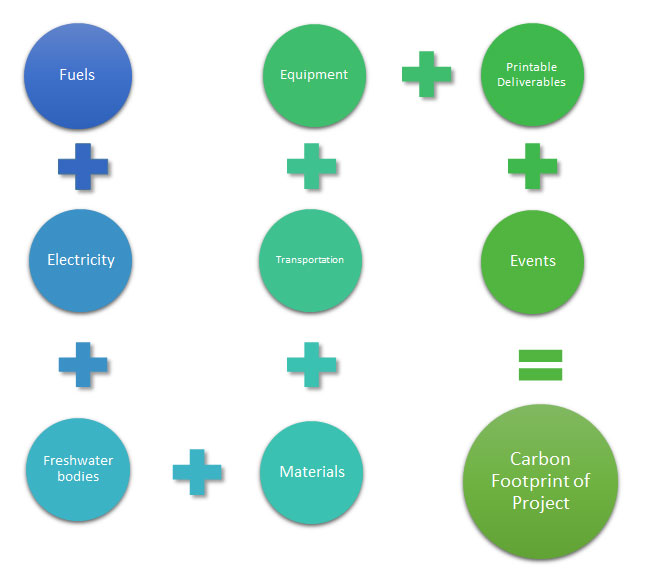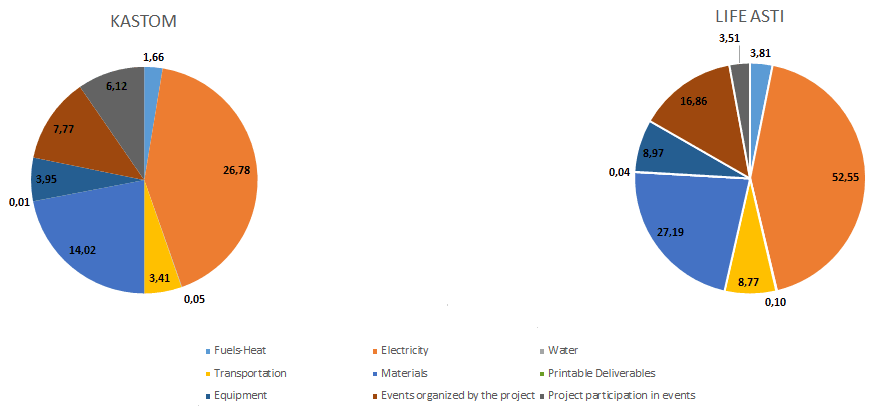by Sofia Papadogiannaki, Natalia Liora (Aristotle University of Thessaloniki) and Anastasia Poupkou (Academy of Athens)
Discover the significance of the carbon footprint (CF) in addressing climate change and shaping sustainability strategies for research projects. This article explores a comprehensive methodology drawing from key data elements, delving into emission sources like electricity, materials, transportation and events. Uncover how this meticulous approach, showcased through a case study of two research projects, provides actionable insights into reducing environmental impact and steering toward a greener future.
The CF encapsulates the collective greenhouse gas (GHG) emissions, both direct and indirect, emanating from individual, organisational or communal activities. This comprehensive metric takes into account emissions from various sources, including energy use, transportation and waste generation. It involves quantifying gases including carbon dioxide (CO2), methane (CH4), nitrous oxide (N2O), and converting them to a unified measurement – tons of CO2 equivalents (tCO2e) – which reflects their relative global warming potential (GWP). Understanding and calculating the CF is pivotal in addressing the urgent issue of climate change. As the global community strives to achieve ambitious climate targets, gauging the CF assumes significance. By assessing the impact of research projects through CF calculations, valuable insights are gained into emissions patterns, aiding in the formulation of effective strategies to reduce environmental impact and steer toward a sustainable future.
The methodology to calculate the CF draws upon key data elements and emission sources, ensuring a robust and comprehensive assessment. The CF methodology has been developed in the framework of the WECAREMED (an Interreg Euro-MED) project (L1) and is based on emission factors taken from widely used established methodologies, such as the GHG Protocol Guidance and DEFRA (Department for Environment Food & Rural Affairs) emission factors [1]. This approach involves consideration of various emission sources, including fuels, electricity, freshwater bodies, materials, events, printable deliverables and technological equipment. These components collectively contribute to the CF of research projects. By leveraging the emissions factors and protocols from these sources, the methodology creates a structured framework for evaluating the environmental impact of each project facet. This analysis empowers the development of actionable strategies to curtail emissions and foster sustainability, aligning with broader environmental goals, such as achieving net zero emissions by 2050 in EU.
The overall CF of a project emerges as the sum total of emissions originating from the aforementioned emission sources [2], as shown in Figure 1. Each of these emissions sources is evaluated in the methodology, ensuring a comprehensive assessment of the project's overall CF. Emissions from fuel use, particularly for heating purposes, are intricately calculated. Similarly, the electricity consumed by project participants is assessed with specific consideration to the emissions factors associated with each country. Moreover, the methodology delves into the carbon impact of water supply and treatment, taking into account the intricate processes involved. Furthermore, the emissions linked to the transportation activities of employees, such as work commutes, are quantified using pertinent data related to distance traveled, mode of transportation and conversion factors.

Figure 1: Scheme of carbon footprint calculation.
Furthermore, the emissions related to material usage and disposal involve different sources, classified based on material origin – primary, recycled or reused. For instance, emissions from primary materials account for extraction, processing, manufacturing and transportation, while those from recycled materials consider sorting, processing and transportation. Furthermore, IT equipment's primary production contributes to the CF, with emissions calculated using data on device quantities and appropriate emissions factors. The methodology also scrutinises events' emissions, including those from fuels, electricity, water, materials, transportation and hotel stays. This comprehensive analysis considers variables such as energy usage, transportation modes, distances traveled and participation type to precisely estimate emissions associated with events. Overall, this meticulous approach provides a holistic understanding of a project's carbon footprint, aiding in the formulation of effective mitigation strategies.
The methodology was applied using a case study approach to assess the dynamics of the CF in two research projects, KASTOM ("Innovative Air Quality Monitoring and Prediction System") and LIFE ASTI ("Implementation of a Prediction System for the Urban Heat Island Effect"). Running from 2018 to 2022, these projects seek to delve into their environmental ramifications and CF results. While KASTOM centers on research collaboration with businesses, the LIFE ASTI project prioritises external outreach and policy-making endeavours.
Figure 2 offers a comprehensive analysis of the carbon footprints, quantified in tCO2e, encompassing the entire duration of the KASTOM and LIFE ASTI projects. The primary contributor to these footprints is electricity consumption, constituting approximately 41.9% for KASTOM and 43.1% for LIFE ASTI. Both projects are significantly influenced by materials and transportation in shaping their carbon footprints, with materials contributing around 22% to KASTOM's CF and approximately 22.3% to LIFE ASTI's, along with transportation at 5.4% and 7.2%, respectively. Further examination of individual emission sources underscores the substantial impact of project-hosted events, accounting for 12.2% to 13.9% of the two projects' footprints. This is followed by the influence of fuels and participation in external events. Remarkably, LIFE ASTI exhibits a notably higher total CF of 121.79 tCO2e in contrast to KASTOM's 63.77 tCO2e.

Figure 2: Carbon footprints of KASTOM and LIFE ASTI projects (tCO2e).
Considering KASTOM's smaller workforce of 37 compared to LIFE ASTI's 71 employees, it is reasonable to anticipate a correspondingly lower total CF for KASTOM. Additionally, the distribution of emissions across different sources carries significance. Specifically, LIFE ASTI may display elevated emissions in specific categories such as electricity consumption, transportation, materials and equipment. The unique nature and scope of the projects further contribute to emission disparities, as LIFE ASTI places emphasis on external outreach and policy-making, which could entail activities with higher emissions.
To improve the projects' carbon footprints, focusing on cutting electricity and material contributions is vital. Efficient measures include shifting to energy-efficient LED lamps, using manual lighting controls and harnessing natural light to reduce energy use. Collecting data on electricity consumption via power-management systems aids informed decisions. Practices like adopting energy-efficient equipment and renewable energy sources, can yield substantial savings. Promoting energy-saving behaviours, turning off unused devices and encouraging reuse and recycling are effective strategies. These actions collectively lead to reduced carbon footprints and a greener workplace.
Links:
[L1] https://wecaremed.interreg-med.eu/
References:
[1] UK Department for Environmental, Food and Rural Affairs, “Greenhouse gas reporting: conversion factors 2021”. Accessed: Aug. 29, 2023. [Online]. Available: https://www.gov.uk/government/publications/greenhouse-gas-reporting-conversion-factors-2021
[2] N. Liora, et al., “A methodology for carbon footprint estimations of research project activities – a scenarios analysis for reducing carbon footprint”, Atmosphere, 14, 6, 2022. [Online]. Available: https://doi.org/10.3390/atmos14010006
Please contact:
Anastasia Poupkou, Academy of Athens, Greece










